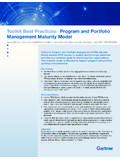Transcription of PUBLIC FINANCE MANAGEMENT ACT - National Treasury
1 1 PUBLIC FINANCE MANAGEMENT ACT NO. 1 OF 1999 [ASSENTED TO 2 MARCH, 1999] [DATE OF COMMENCEMENT: 1 APRIL, 2000] (Unless otherwise indicated) (English text signed by the President) National Treasury This Act has been updated to Government Gazette 33059 dated 1 April, 2010. as amended by PUBLIC FINANCE MANAGEMENT Amendment Act, No. 29 of 1999 Local Government: Municipal Systems Act, No. 32 of 2000 Judicial Officers (Amendment of Conditions of Service) Act, No. 28 of 2003 [with effect from 1 November, 2003] PUBLIC Audit Act, No. 25 of 2004 Broadband Infraco Act, No. 33 of 2007 South African Express Act, No. 34 of 2007 PUBLIC Service Amendment Act, No. 30 of 2007 [with effect from 1 April, 2008] South African Airways Act, No. 5 of 2007 [with effect from 13 July, 2009] Financial MANAGEMENT of Parliament Act, No.
2 10 of 2009 ACT To regulate financial MANAGEMENT in the National government and provincial governments; to ensure that all revenue, expenditure, assets and liabilities of those governments are managed efficiently and effectively; to provide for the responsibilities of persons entrusted with financial MANAGEMENT in those governments; and to provide for matters connected therewith. 2 [Long title substituted by s. 47 of Act No. 29 of 1999.] ARRANGEMENT OF SECTIONS [Arrangement of sections amended by s. 48 of Act No. 29 of 1999.] CHAPTER 1 INTERPRETATION, OBJECT, APPLICATION AND AMENDMENT OF THIS ACT 1. Definitions 2. Object of this Act 3. Institutions to which this Act applies 4. Amendments to this Act CHAPTER 2 National Treasury AND National REVENUE FUND Part 1: National Treasury 5.
3 Establishment 6. Functions and powers 7. Banking, cash MANAGEMENT and investment framework 8. Annual consolidated financial statements 9. Financial statistics and aggregations 10. Delegations by National Treasury Part 2: National Revenue Fund 11. Control of National Revenue Fund 12. Deposits and withdrawals by South African Revenue Services in Revenue Funds 13. Deposits into National Revenue Fund 14. Withdrawal of exclusions 15. Withdrawals and investments from National Revenue Fund 16. Use of funds in emergency situations CHAPTER 3 PROVINCIAL TREASURIES AND PROVINCIAL REVENUE FUNDS Part 1: Provincial Treasuries 17. Establishment 18. Functions and powers 19. Annual consolidated financial statements 20. Delegations by provincial treasuries 3 Part 2: Provincial Revenue Funds 21. Control of Provincial Revenue Fund 22.
4 Deposits by provincial departments into Provincial Revenue Fund 23. Withdrawal of exclusions from Provincial Revenue Funds 24. Withdrawals from Provincial Revenue Funds 25. Use of funds in emergency situations CHAPTER 4 National AND PROVINCIAL BUDGETS 26. Annual appropriations 27. National annual budgets 28. Multi-year budget projections 29. Expenditure before annual budget is passed 30. National adjustments budgets 31. Provincial adjustments budgets 32. Publishing of reports on state of budget 33. Withholding of appropriated funds 34. Unauthorised expenditure 35. Unfunded mandates CHAPTER 5 DEPARTMENTS AND CONSTITUTIONAL INSTITUTIONS Part 1: Appointment of Accounting Officers 36. Accounting officers 37. Acting accounting officers Part 2: Responsibilities of Accounting Officers 38. General responsibilities of accounting officers 39.
5 Accounting officers responsibilities relating to budgetary control 40. Accounting officers reporting responsibilities 41. Information to be submitted by accounting officers 42. Accounting officers responsibilities when assets and liabilities are transferred 43. Virement between main divisions within votes Part 3: Other Officials of Departments and Constitutional Institutions 44. Assignment of powers and duties by accounting officers 45. Responsibilities of other officials 4 CHAPTER 6 PUBLIC ENTITIES Part 1: Application of this Chapter 46. Application 47. Unlisted PUBLIC entities 48. Classification of PUBLIC entities Part 2: Accounting Authorities for PUBLIC Entities 49. Accounting authorities 50. Fiduciary duties of accounting authorities 51. General responsibilities of accounting authorities 52.
6 Annual budget and corporate plan by Schedule 2 PUBLIC entities and government business enterprises 53. Annual budgets by non-business Schedule 3 PUBLIC entities 54. Information to be submitted by accounting authorities 55. Annual report and financial statements Part 3: Other Officials of PUBLIC Entities 56. Assignment of powers and duties by accounting authorities 57. Responsibilities of other officials Part 4: External Auditors 58.. 59.. 60.. 61.. 62.. CHAPTER 7 EXECUTIVE AUTHORITIES 63. Financial responsibilities of executive authorities 64. Executive directives having financial implications 65. Tabling in legislatures CHAPTER 8 LOANS, GUARANTEES AND OTHER COMMITMENTS Part 1: General Principles 66. Restrictions on borrowing, guarantees and other commitments 67. No provincial foreign commitments 5 68.
7 Consequences of unauthorised transactions 69. Regulations on borrowing by PUBLIC entities 70. Guarantees, indemnities and securities by Cabinet members Part 2: Loans by National Government 71. Purposes for which Minister may borrow money 72. Signing of loan agreements 73. Interest and repayments of loans to be direct charges 74. Repayment, conversion and consolidation of loans 75. Obligations from lien over securities CHAPTER 9 GENERAL Treasury MATTERS 76. Treasury regulations and instructions 77. Audit committees 78. Publishing of draft Treasury regulations for PUBLIC comment 79. Departures from Treasury regulations, instructions or conditions 80. Determination of interest rates for debt owing to state CHAPTER 10 FINANCIAL MISCONDUCT Part 1: Disciplinary Proceedings 81. Financial misconduct by officials in departments and constitutional institutions 82.
8 Financial misconduct by Treasury officials 83. Financial misconduct by accounting authorities and officials of PUBLIC entities 84. Applicable legal regime for disciplinary proceedings 85. Regulations on financial misconduct procedures Part 2: Criminal Proceedings 86. Offences and penalties CHAPTER 11 ACCOUNTING STANDARDS BOARD 87. Establishment 88. Composition 89. Functions of Board 90. Powers of Board 6 91. Regulations on accounting standards of Board CHAPTER 12 MISCELLANEOUS 92. Exemptions 93. Transitional provisions 94. Repeal of legislation 95. Short title and commencement Schedule 1. Constitutional institutions Schedule 2. Major PUBLIC entities Schedule 3. Other PUBLIC entities Schedule 4. Exclusions from revenue funds Schedule 5. Direct charges against National revenue fund Schedule 6. Repeal of legislation CHAPTER 1 INTERPRETATION, OBJECT, APPLICATION AND AMENDMENT OF THIS ACT 1.
9 Definitions. In this Act, unless the context otherwise indicates accounting officer means a person mentioned in section 36; accounting authority means a body or person mentioned in section 49; Accounting Standards Board means the board established in terms of section 87; annual Division of Revenue Act means the Act of Parliament which must annually be enacted in terms of section 214 (1) of the Constitution; constitutional institution means an institution listed in Schedule 1; department means a National or provincial department or a National or provincial government component; [Definition of department substituted by s. 1 (a) of Act No. 29 of 1999 and by s. 43 of Act No. 30 of 2007.] executive authority (a) in relation to a National department, means the Cabinet member who is accountable to Parliament for that department; 7 (b) in relation to a provincial department, means the member of the Executive Council of a province who is accountable to the provincial legislature for that department; (c) in relation to a National PUBLIC entity, means the Cabinet member who is accountable to Parliament for that PUBLIC entity or in whose portfolio it falls; and (d) in relation to a provincial PUBLIC entity, means the member of the provincial Executive Council who is accountable to the provincial legislature for that PUBLIC entity or in whose portfolio it falls; [Definition of executive authority substituted by s.]
10 1 (b) of Act No. 29 of 1999.] financial year (a) means a year ending 31 March; or (b) in relation to a PUBLIC entity that existed when this Act took effect and that has a different financial year in terms of other legislation, means that financial year, provided the National Treasury has approved that other financial year; [Para. (b) amended by s. 1 (c) of Act No. 29 of 1999.] financial statements means statements consisting of at least (a) a balance sheet; (b) an income statement; (c) a cash-flow statement; (d) any other statements that may be prescribed; and (e) any notes to these statements; fruitless and wasteful expenditure means expenditure which was made in vain and would have been avoided had reasonable care been exercised; 8 generally recognised accounting practice means an accounting practice complying in material respects with standards issued by the Accounting Standards Board; irregular expenditure means expenditure, other than unauthorised expenditure, incurred in contravention of or that is not in accordance with a requirement of any applicable legislation, including (a) this Act.

















